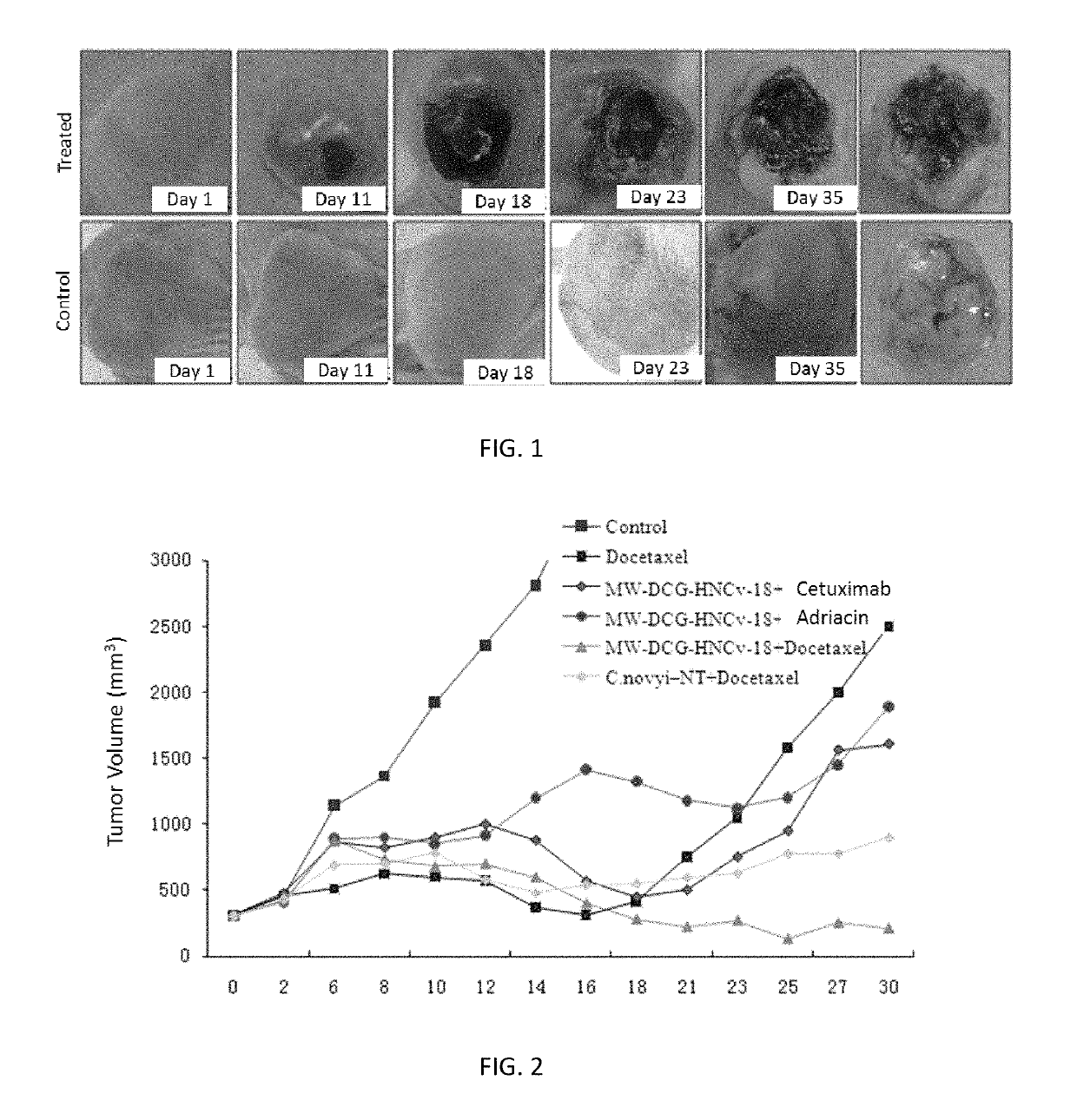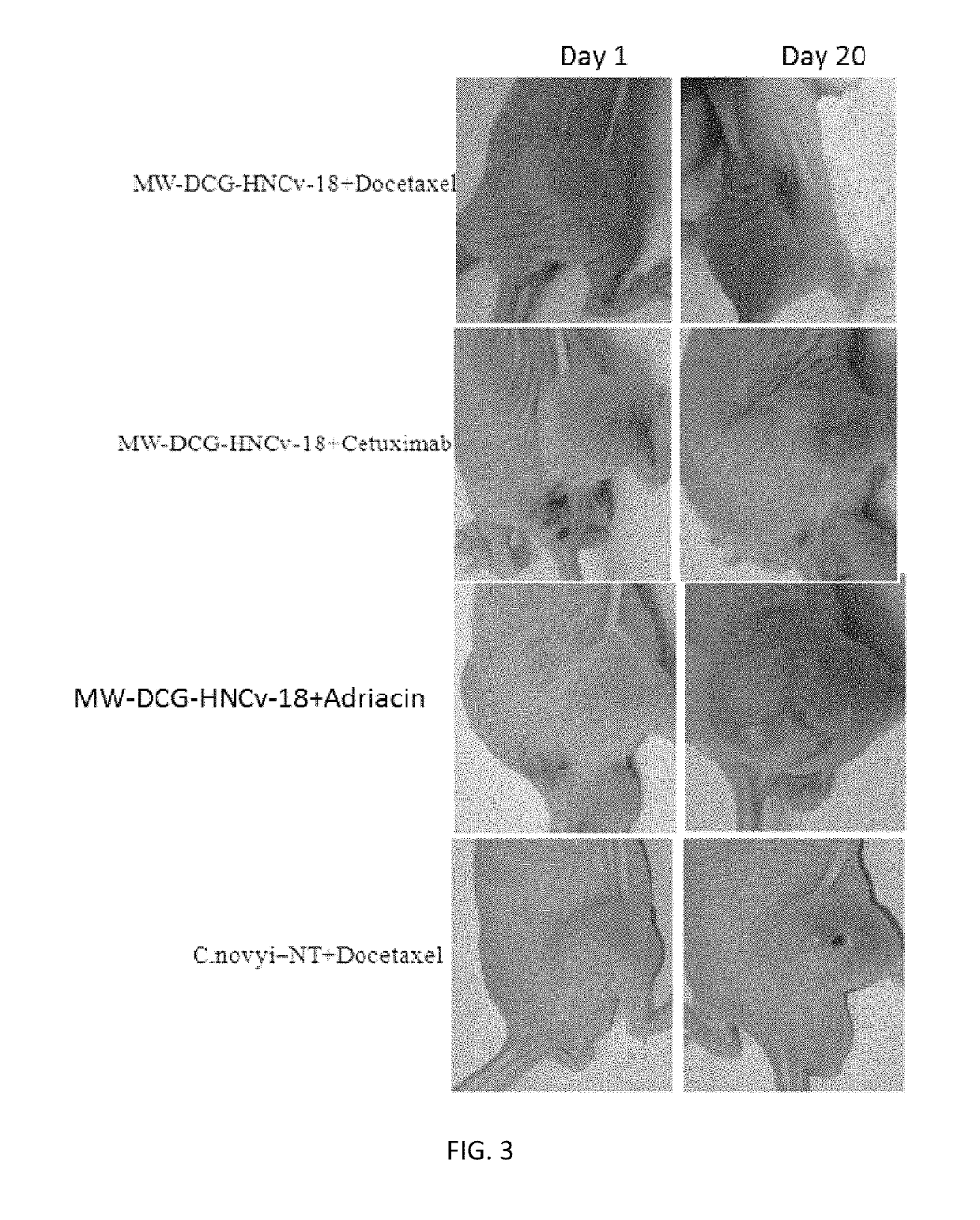Application of derivative of clostridium ghonii
a technology of clostridium ghonii and derivatives, which is applied in the field of application of derivatives of clostridium ghonii, can solve the problems of ineffective treatment of hypoxic areas by conventional chemotherapy, damage to dna mitotic cells, and inability to achieve effective treatment of hypoxic areas, so as to improve the oncolytic effect, facilitate dcg colonization, and increase the degree of hypoxia
- Summary
- Abstract
- Description
- Claims
- Application Information
AI Technical Summary
Benefits of technology
Problems solved by technology
Method used
Image
Examples
example 1
Study Method:
□Construction of Non-Small Cell Lung Carcinoma Models
[0029]The non-small cell lung carcinoma A549 cells were injected into the subcutaneous positions at femoral lateral parts of right backs of female Balb / c-nu / nu nude mice (5 weeks old, 20 g) by subcutaneous injection. The in-vivo anti-tumor test was performed when the tumor volume was 300 mm3.
② Animal Grouping and Processing
[0030]Control group: n=15 (n is the number of animals in each group), and 0.2 ml of PBS buffer was intravenously injected to the tails;
[0031]MW-DCG-HNCv-18 spore group: n=15, spores were intravenously injected to the tails on the first day, and the dose was 3×108 / (kg·body weight).
[0032]MW-DCG-LCv-26 spore group: n=15, spores were intravenously injected to the tails on the first day, and the dose was 3×108 / (kg·body weight).
[0033]MW-DCG-CCv-17 spore group: n=15, spores were intravenously injected to the tails on the first day, and the dose was 3×108 / (kg·body weight).
[0034]C. novyi-NT spore group: n=15...
example 2
Study Method:
① Construction of Non-Small Cell Lung Carcinoma Models
[0045]The non-small cell lung carcinoma A549 cells were injected into the subcutaneous positions at femoral lateral parts of right backs of female Balb / c-nu / nu nude mice (5 weeks old, 20 g) by subcutaneous injection. The in-vivo test was performed when the tumor volume was 300 mm3.
② Animal Grouping and Processing
[0046]Control group: n=15, and 0.2 ml of PBS buffer was intravenously injected to the tails;
[0047]Docetaxel group: n=15, Docetaxel was intravenously injected to the tails on the 4th day and 11th day, the dose was 20 mg / (kg·body weight), and the application dose of Docetaxel was the optimal application dose.
[0048]MW-DCG-HNCv-18 spore group: n=15, spores were intravenously injected to the tails, and the dose was 3×108 / (kg·body weight).
[0049]MW-DCG-HNCv-18 spore+Cetuximab group: n=15, MW-DCG-HNCv-18 spores were intravenously injected to the tails on the first day, and the dose was 3×108 / (kg·body weight); Cetuxim...
example 3
Study Method:
① Construction of Non-Small Cell Lung Carcinoma Models
[0063]The non-small cell lung carcinoma A549 cells were injected into the subcutaneous positions at femoral lateral parts of right backs of female Balb / c-nu / nu nude mice (5 weeks old, 20 g) by subcutaneous injection. The in-vivo test was performed when the tumor volume was 300 mm3.
② Animal Grouping and Processing
[0064]Control group: n=15, and 0.2 ml of PBS buffer was intravenously injected to the tails;
[0065]MW-DCG-HNCv-18 spore+Docetaxel-1 group: n=15, MW-DCG-HNCv-18 spores were intravenously injected to the tails on the first day, and the dose was 0.5×108 / (kg·body weight); Docetaxel was intravenously injected to the tails on the 4th day and 11th day, and the dose was 20 mg / (kg·body weight).
[0066]MW-DCG-HNCv-18 spore+Docetaxel-2 group: n=15, MW-DCG-HNCv-18 spores were intravenously injected to the tails on the first day, and the dose was 1.0×108 / (kg·body weight); Docetaxel was intravenously injected to the tails on ...
PUM
| Property | Measurement | Unit |
|---|---|---|
| diameter | aaaaa | aaaaa |
| width | aaaaa | aaaaa |
| volume | aaaaa | aaaaa |
Abstract
Description
Claims
Application Information
 Login to View More
Login to View More - R&D
- Intellectual Property
- Life Sciences
- Materials
- Tech Scout
- Unparalleled Data Quality
- Higher Quality Content
- 60% Fewer Hallucinations
Browse by: Latest US Patents, China's latest patents, Technical Efficacy Thesaurus, Application Domain, Technology Topic, Popular Technical Reports.
© 2025 PatSnap. All rights reserved.Legal|Privacy policy|Modern Slavery Act Transparency Statement|Sitemap|About US| Contact US: help@patsnap.com


